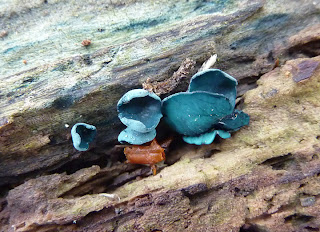Made it!
It may not be a spectacular looking species, but Bitter Bracket became my 3,000th pan-species yesterday morning whilst on the hunt at Reigate Heath. I would have liked that honour to have gone to Ceratiomyxa fraticulosa, a species of slime mould that I was rather taken with, but that came in at 2,998. That's it to right of Sir Winston (above). Before any of you go thinking that I've suddenly become an expert in slime moulds, I haven't. I know as much about them as I do 19th century Russian ballerinas - it just so happens that this species is illustrated in a mycology book that I own, and my double-checking online suggests that the identification is correct. Reigate Heath also supplied White Brain, Liver Milkcap, Yellow Fieldcap and Turf Mottlegill. Above all of this fungi action, two male Crossbills entertained me feeding in conifers only yards away.
I then went on to Juniper Bottom, taking in Box Hill and Juniper Top. The new fungi species kept on coming, with Cabbage Parachute, Lemon Disco, Green Elfcup (pictured left), Scarlet Bonnet, Sheathed Woodtuft, Matt Bolete and some interesting white furry thing called Coprinopsis stercora growing out of cow dung. The pan-species list is now 3,012.
I had set myself the task of reaching 3,000 by the end of this year back in the spring. There have been times when I've gone for it and others when I've let it slide, but the past month has seen me targeting the 'low hanging fruit' that is fungi. There are lots of them and plenty are easy to identify. I've enjoyed it immensly and can add fungi to my list of groups that I will count as favourites. I am mindful that this pan-species listing can water down my deeper knowledge of other groups - to be perfectly honest since diversifying away from birds my prowess as a birder has fallen. My ability to name moths and plants on sight has also taken a step back (although a year of immersing myself back into them should bring that back).
What of the pan-species future? I will continue to keep the list, but maybe resist the temptation to take on groups that will provide lots of ticks (mosses, lichens, 'other' insects) as the time spent becoming proficient with them is time that I don't have at my disposal. It's going to be time better spent getting back into the birding, mothing and botanising. But mosses do look interesting...




Comments
Now for the magic number, 5000?
Go for the mosses. There is a cracking book on them by the British Bryological Society. The society is also only about £20 to join and produces a cracking magazine to wipe the floor even with high street glossies.